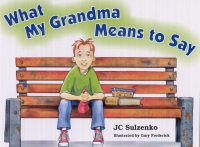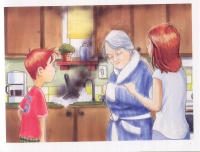| ________________
CM . . . . Volume XVII Number 40. . . .June 17, 2011. 
 |
What My Grandma Means to Say: With Questions, Answers, and Sources of Further Information About Alzheimer’s Disease.
J.C. Sulzenko. Illustrated by Gary Federick.
Renfrew, ON: General Store Publishing House, 2011.
37 pp., pbk., $12.95.
ISBN 978-1-926962-08-5.
Grades 3-6 / Ages 8-11.
Review by Valerie Nielsen.
***/4
|
| |
|

excerpt:
Hi! My name is Jacob, but everybody calls me “Jake”. You can call me Jake, too, if you
like… I have a story to tell you. It’s a story with a lot of truth in it. Once you’ve heard it, you can make up you own mind about whether it leaves you a little bit happy, hopeful, or sad—or a mix of all three. That’s up to you.
Jacob’s story focuses on the way he must learn to cope with his grandmother’s day by day loss of memory and change of personality due to Alzheimer’s disease. The reader follows Jake as he struggles to understand what is happening to his beloved grandma, and what ways he and his mother can support her. The book’s realistic illustrations in bright primary colours are perfectly suited to the ordinary-life tone and homey setting of Jake’s narrative.
Author J.C. Sulzenko says in the preface to What My Grandma Means to Say:
“What drove me to tell the story, from the outset, was the need to give children and their families a way to discuss Alzheimer’s disease and related dementias at a “safe” distance from the situation that affects the person they know and love.”
Sulzenko hopes that, by reading and discussing Jake’s story at home, or in the classroom or library, families may learn how to best support both the individual with dementia and each other. The author originally wrote Jake’s story as a play, complete with discussion guide, activities and frequently asked questions to use in educational settings. The play and guide were adopted by the Alzheimer Society of Ottawa and have been seen appreciated by many students, families, teachers and health-care professionals. Pressure from such audiences led to the author’s decision to write Jake’s “back story” in the form of an illustrated children’s book. Considering that the play has been transformed into an illustrated book for children, it becomes necessary to base the evaluation of What My Grandma Means to Say on its success as a story appealing to elementary school readers, rather than its success as an informational resource.
 The main problem for the author of What My Grandma Means to Say is turning 11-year-old Jake into a believable character as the narrator of his story. On stage, a good part of the responsibility for this task lies with the actor and his rapport with the audience. A compelling young actor and a sympathetic audience will usually soften a didactic style. However, it is not so easy to do the same using the printed word, particularly when the message is paramount. Too often in What My Grandma Means to Say, Jake’s facility with words and his ability to recount past conversations with his mother and grandmother seem unconvincing. Could it be that he never was impatient or frustrated with his grandma before the incident wherein he believes his grandma has made a miraculous recovery? Both Jake’s mother, with her endless patience and Jake with his total devotion, seem too good to be true to life. The main problem for the author of What My Grandma Means to Say is turning 11-year-old Jake into a believable character as the narrator of his story. On stage, a good part of the responsibility for this task lies with the actor and his rapport with the audience. A compelling young actor and a sympathetic audience will usually soften a didactic style. However, it is not so easy to do the same using the printed word, particularly when the message is paramount. Too often in What My Grandma Means to Say, Jake’s facility with words and his ability to recount past conversations with his mother and grandmother seem unconvincing. Could it be that he never was impatient or frustrated with his grandma before the incident wherein he believes his grandma has made a miraculous recovery? Both Jake’s mother, with her endless patience and Jake with his total devotion, seem too good to be true to life.
There are a number of excellent picture books for young people which share Sulzenko’s theme and purpose but are much less message-driven. One of the best is Mem Fox’s Wilfred Gordon McDonald Partridge, published in 1985; another is Laura Langston’s Mile High Apple Pie (a touching story of the relationship between a young girl and a grandmother beset by Alzheimer’s) and a third is simply written and beautifully illustrated picture book entitled Grandpa’s Music by Alison Acheson published in 2009. Reading and sharing any or all of these books with children would be an excellent prelude to a family or classroom discussion of the “old-timer’s” disease and a nice segue into a literature circle or classroom reading of What My Grandma Means to Say.
Recommended.
Valerie Nielsen, a retired teacher-librarian, lives in Winnipeg, MB.

To comment on this title or this review, send mail to
cm@umanitoba.ca.
Copyright © the Manitoba Library Association. Reproduction for personal use is permitted only if this copyright notice is maintained. Any other reproduction is prohibited without permission.
NEXT REVIEW |
TABLE OF CONTENTS FOR THIS ISSUE- June 17, 2011.
AUTHORS |
TITLES |
MEDIA REVIEWS |
PROFILES |
BACK ISSUES |
SEARCH |
CMARCHIVE |
HOME |

 The main problem for the author of What My Grandma Means to Say is turning 11-year-old Jake into a believable character as the narrator of his story. On stage, a good part of the responsibility for this task lies with the actor and his rapport with the audience. A compelling young actor and a sympathetic audience will usually soften a didactic style. However, it is not so easy to do the same using the printed word, particularly when the message is paramount. Too often in What My Grandma Means to Say, Jake’s facility with words and his ability to recount past conversations with his mother and grandmother seem unconvincing. Could it be that he never was impatient or frustrated with his grandma before the incident wherein he believes his grandma has made a miraculous recovery? Both Jake’s mother, with her endless patience and Jake with his total devotion, seem too good to be true to life.
The main problem for the author of What My Grandma Means to Say is turning 11-year-old Jake into a believable character as the narrator of his story. On stage, a good part of the responsibility for this task lies with the actor and his rapport with the audience. A compelling young actor and a sympathetic audience will usually soften a didactic style. However, it is not so easy to do the same using the printed word, particularly when the message is paramount. Too often in What My Grandma Means to Say, Jake’s facility with words and his ability to recount past conversations with his mother and grandmother seem unconvincing. Could it be that he never was impatient or frustrated with his grandma before the incident wherein he believes his grandma has made a miraculous recovery? Both Jake’s mother, with her endless patience and Jake with his total devotion, seem too good to be true to life.